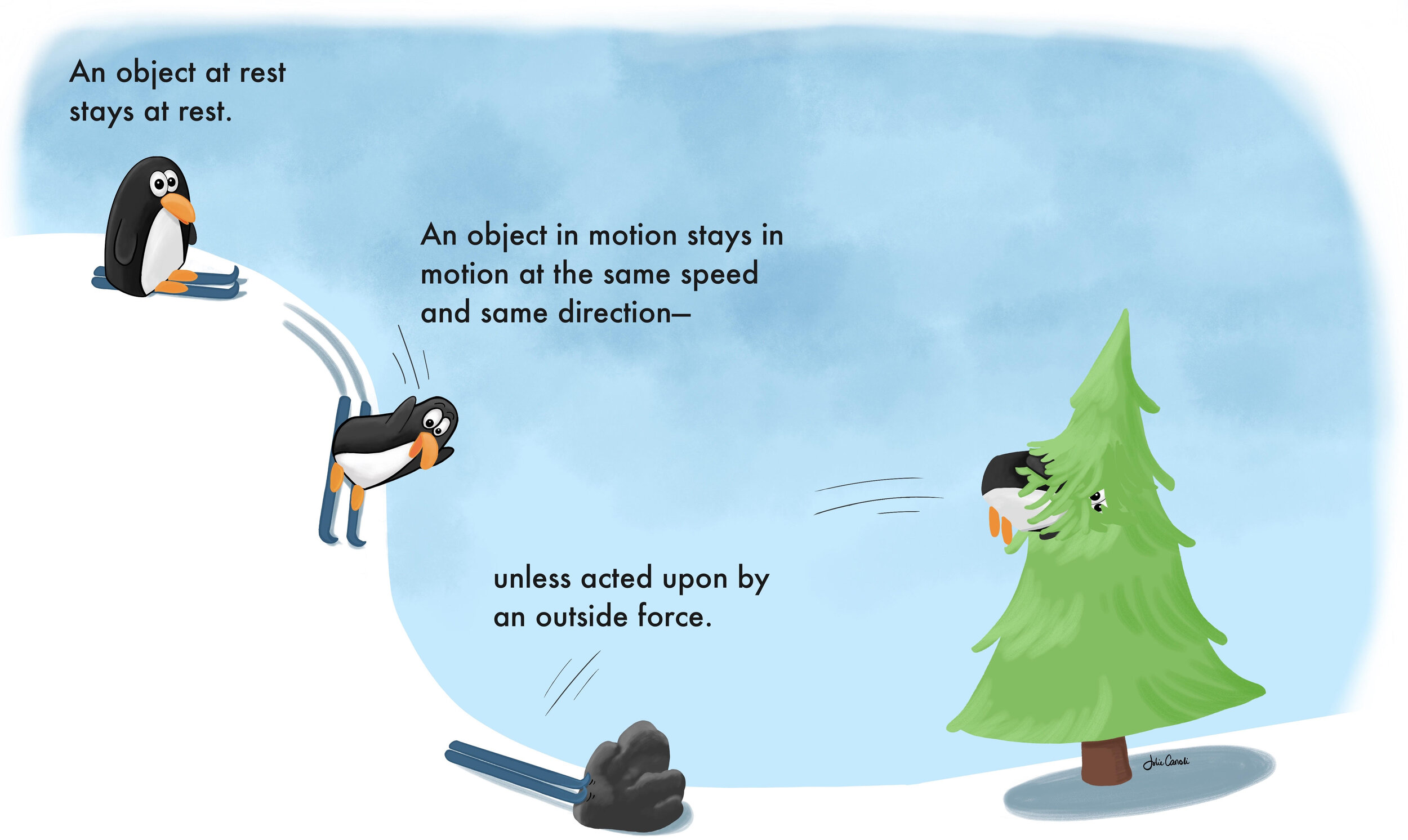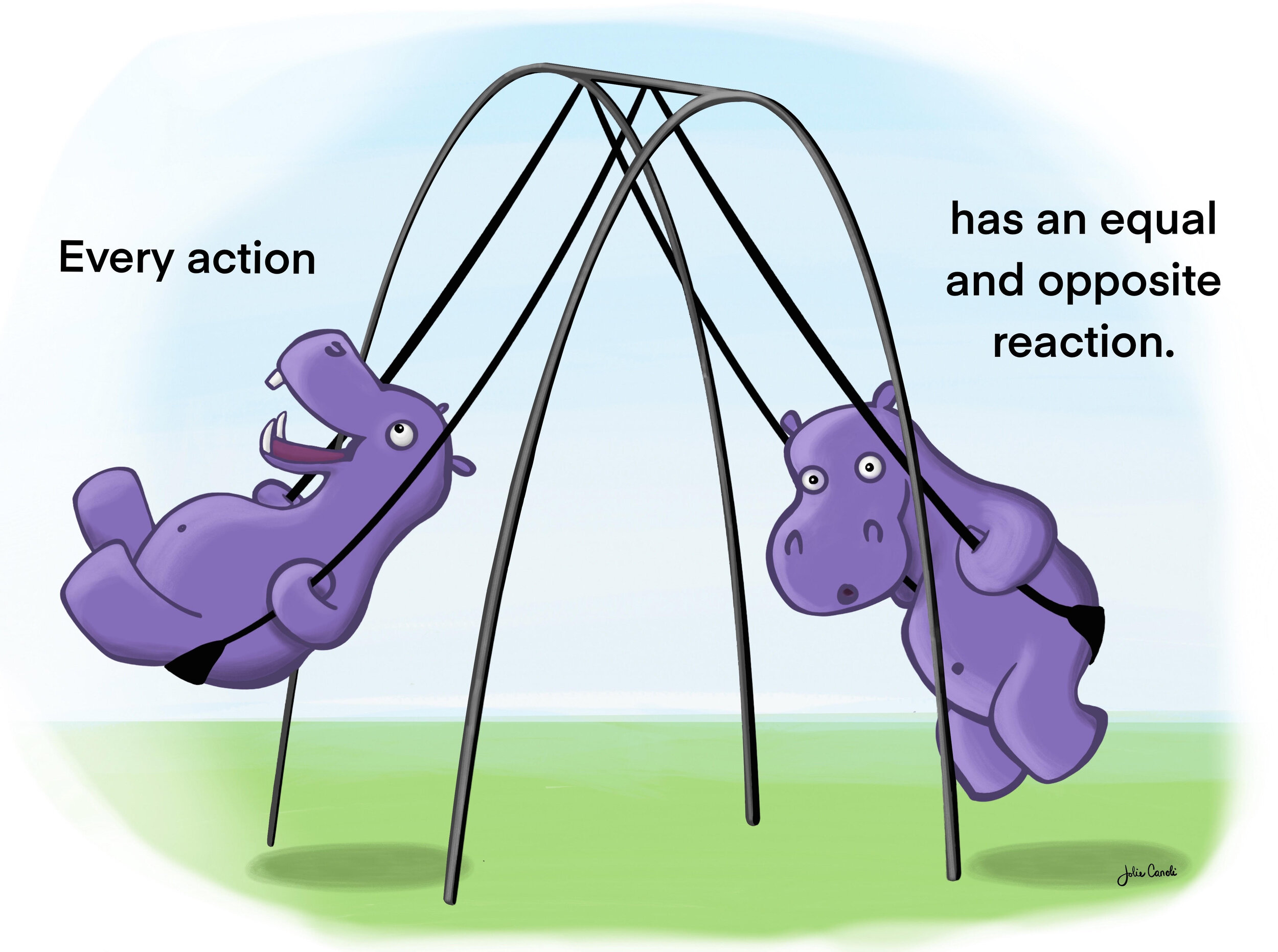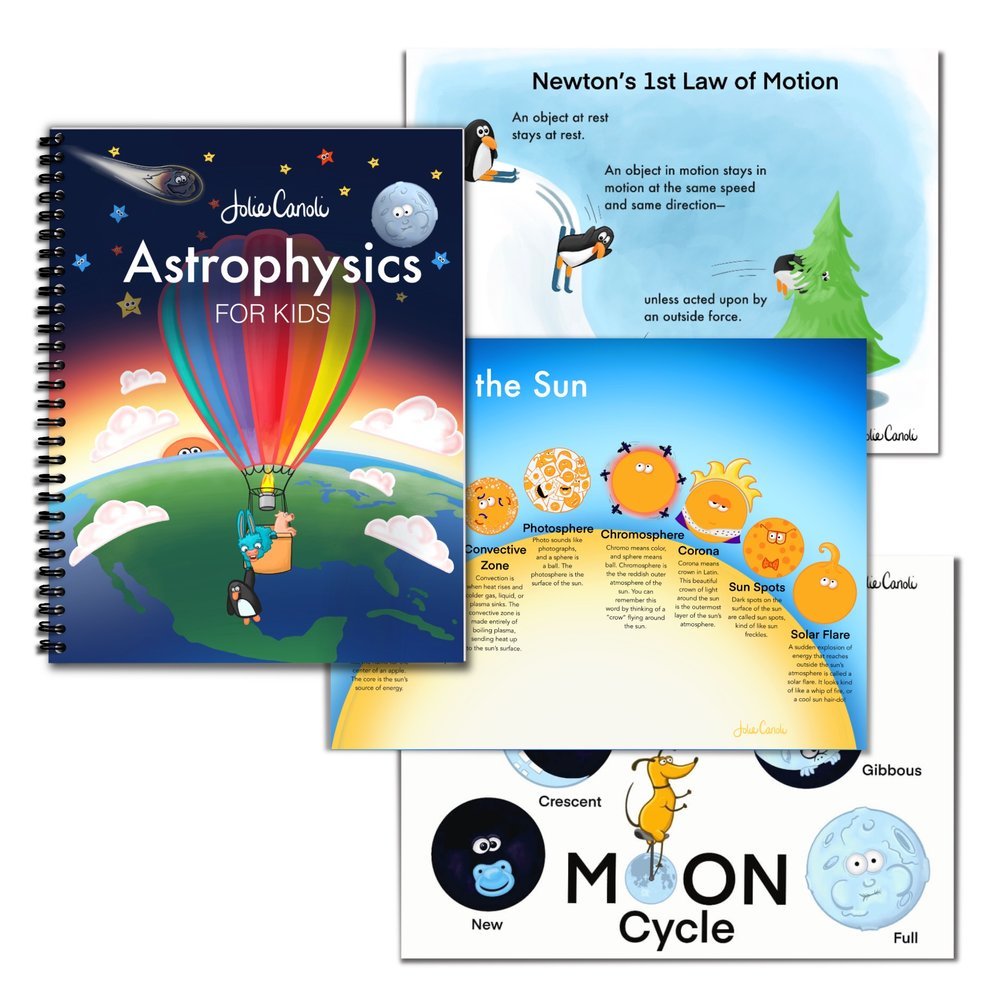NEWTON’S 1ST LAW
An object at rest tends to stay at rest. An object in motion stays in motion at the same speed and direction unless acted upon by an outside force.
Newtonʻs first law shows us that nothing moves, changes direction, speeds up, slows down, or stops without something making it happen. Newton’s first law could be summed up like this: things want to keep doing what they are doing. Sort of like a kid that wants to keep playing with his toys, or a kid that doesnʻt want to wake up in the morning, objects in the universe want to keep doing what they were doing.
An object at rest stays at rest…
Imagine a ball sitting on the ground. Even though it is round, and easily rolls, it isnʻt going to move on its own. It will remain “at rest.” A little push, kick, or some other force, and the ball will move. Once the ball begins to move the ball would go one direction, and continue going that way, until something makes it change direction. If someone else kicks the ball, the ball hits something, or the ground is uneven, these things would affect the direction and speed of the ball.
If you kicked a ball straight up, this law says it would keep going straight up and never stop, right? Wait— thatʻs not what a ball does! It goes up, but then slows down, and falls back down. Why is that? Newtonʻs first law tells us that some kind of force must be making the ball change direction and speed. Do you know a force that would make the ball change speed and direction? If you guessed gravity, you would be right! Gravity is a force that is always at work on planet earth. But did you know that the ball would never stop if it was in outer space? As long as the ball never ran into anything, the ball would keep going in the same direction, at the same speed, forever.
So if you kicked a ball on the grass, would it keep rolling forever and ever and never stop? No, eventually the ball will stop. Why is that? Newtonʻs law tell us that a force must be responsible for making the ball change speed. Can you think of a force that makes the ball stop rolling? If you guessed friction, you were right! Friction is a force of two things rubbing together, and it slows things down. The ball rubs against the grass, eventually bringing it to a stop. If the ground was very smooth, the ball would travel farther than if it had to push through lots of grass or along carpet.
Now usually there are a lot of forces at work all at once, like gravity, friction, air resistance, and more. All of these forces affect how things move. Newtonʻs law is at work with everything, not just balls.
NEWTON’S 2ND LAW: F=MA
Newtonʻs second law is an equation! When we remember his second law, we can just remember the letters and an equal sign. But in order to understand Newtonʻs second law, we have to understand what those letter mean!
The first letter is F. F stands for FORCE. A force is a push or a pull. When we learned the first law of motion we talked about an “outside force.” That outside force is something that does something to an object- either pushing it, or pulling it.
The second letter is M. M stands for MASS. When I think of mass I think of the word “massive,” like “that is a massive elephant.” Mass is related to size and weight, but it isnʻt either one. We could say “the hedgehog has 1 pound of mass.” Or we might say “the hedgehog has 2 pounds of mass after it has eaten 800 jelly beans.” When we talk about mass we use measurements of weight like pounds, ounces and grams. The difference between mass and weight is that mass is a measurement without the effects of gravity.
For example, letʻs say you have a bowling ball with a weight of 12 pounds. If you take that bowling ball to the moon, it would have a weight of only 2 pounds because their is less gravity on the moon than on earth. The bowling ball did not change size or shape- the only thing that changed was the amount of gravity that pulls on it. But the mass of the bowling ball would never change. A bowling ball with a mass of 12 pounds on earth will have the mass of 12 pounds on the moon! Mass is the amount of atoms that a space fills.
Can you guess why does Newton uses mass instead of weight? Well, Newton was pretty smart. He knew that if he used mass, then his law would work anywhere in the universe. So this equation: F=MA will work on the moon, on Saturn, in a spaceship, or deep underground.
The last letter in this equation is A. A stands for Acceleration. Acceleration is an increase of speed, or velocity. If a rocket ships accelerates, it goes faster. If a rocket ship loses acceleration, it moves slower.
If we put all these letter together, we get this sentence:
Force equals Mass times Acceleration.
Newton’s 2nd Law law tells us several things with just three letters!
It tells us the greater the mass an object has, the greater the force is needed to make it move.
It tells us when a force acts upon an object, it makes it speed up, or accelerate.
It tells us the greater the force, the greater the acceleration.
If this elephant uses enough force, it can get this massive truck of farm animals to accelerate!
When we have this equation we can find use it to discover how much force weʻll need to get something to move, or how fast something will go, or how heavy something might be, or how much more force weʻll need to make in order to go a certain speed. It helps us with all sorts of things! So if I knew a walrus wearing a wedding gown in a wagon was 100 pounds of mass, and I used 300 pounds of force, I could make the walrus wearing a wedding gown in a wagon go 3 times faster.
NEWTON’S 3RD LAW
Every action has an equal and opposite reaction.
To understand Newtonʻs third law, letʻs think of some actions, and how they have equal and opposite reactions! Letʻs start with pushing a box of toys. When you push a box of toys, the box pushes back on you with an equal and opposite force. You can tell it is pushing back on you because you can feel the pressure in your hands, and the weight of the box.
Now imagine you are sitting on a swing. Your mom or dad pushes you. You fly forward and up! But now your swing is going to go in the opposite direction- backwards and down. Back and forth, until the force of gravity and friction of the air makes you slow down- and you ask for another push!
When your mom and dad push you, their action is equal to how high you will swing. If they push you with a lot of force, you will go very high! If they push you with very little force, you wonʻt go very high at all. The bigness of their push is equal to the bigness of your swing!
So now letʻs put the story of swinging into Newtonʻs law.
Every action (big push) has an equal (big swing) and opposite reaction (away from mom).
Every action (little push) has an equal (little swing) and opposite reaction (away from dad).
Now letʻs think of shooting a bunny out of a cannon. The explosive force of the cannon shoots the bunny out of the cannon. The cannon will have an equal and opposite reaction of being pushed backward as the bunny is pushed forward.
Now imagine you are an astronaut in outer space. There is nothing to push; but you have a canister full of gas. You open the gas tank, and the gas escapes. The pressure of the gas moving out of the tank will push you in the opposite direction with an equal amount of force. The gas will flow one way, and because of the force of the gas escaping, it will have an equal and opposite reaction— pushing you away.
This law is at work with every action in the universe! Whatever you push or pull is also pushing or pulling back on you. Even in the simplest things, this law is working. For example, if a book is sitting on a table, the table is pushing back on the book with an equal and opposite force, keeping it from falling through the table. If you are sitting on a chair, the chair is pushing back on you, keeping you seated. Take a look around you. Can you think of some examples of this law at work around you?
Yes please! I’d like a Free PDF! (Includes 3 posters, lessons, and a review quiz.)
Astrophysics for Kids!
Your kids will love learning about the moon, sun, stars, laws of motion, thermodynamics, and more!









